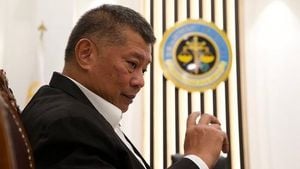A new vision model called TunaVision has been developed to automate frozen tuna processing by leveraging advanced segmentation and pose estimation techniques.
TunaVision is introduced as a vision model based on YOLOv8 for automated processing of frozen tuna, focusing on segmentation and pose estimation. The model employs YOLOv8m-FusionSeg and YOLOv8s RSF to achieve high accuracy and efficiency.
The study was conducted by authors R.C.W., X.S.Z., and Y.C., associated with the Zhoushan Dinghai District Science and Technology Bureau and the Zhoushan Science and Technology Bureau.
The article was published on 2025-03-12.
Research was conducted at Zhoushan Dinghai District, China, with data acquired from Zhejiang Ocean Family Co., Ltd.
There is a need for automated systems to replace labor-intensive manual processes involved in frozen tuna processing, enhancing safety and efficiency.
TunaVision integrates various enhancements including improved segmentation models and pose estimation techniques to achieve high performance metrics (i.e., [email protected] of 93.3% and 96.1%).
The mean absolute error (MAE) for angle estimation using TunaVision was found to be 1.81 degrees, demonstrating its precision.
“TunaVision combines advanced segmentation and pose estimation methods to provide reliable support for frozen tuna processing.” - authors of the article
“Utilizing YOLOv8m-FusionSeg and YOLOv8s RSF ensures the efficiency and accuracy of detection and localization for each fish.” - authors of the article.
The article outlines the significance of tuna processing and introduces the challenges faced, leading to the development of TunaVision.
Contextual information is provided on the nutritional value of tuna and its market significance, detailing the inefficiencies of manual processing methods.
The framework of TunaVision is explained, detailing the technical advancements incorporated within the YOLOv8m-FusionSeg and YOLOv8s RSF models, emphasizing their operational efficiency.
Performance metrics of TunaVision are presented, including comparisons with baseline models, illustrating how it addresses key industry needs.
The conclusion summarizes the contributions of TunaVision to automated processing systems and suggests future developments or integrations with robotic systems.



